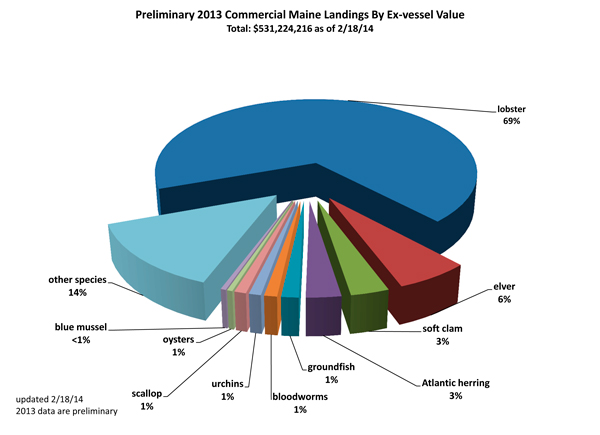LOBSTER MARKETING
continued from Homepage

From left, Luke Holden, Emily Lane and Karen Cushman were among the new Maine Lobster Marketing Collaborative board members giving the first annual report to the industry. Laurie Schreiber photo
members were appointed in November. The collaborative replaces the Maine Lobster Promotion Council and has more money than the council did.
The collaborative is also required to report more frequently on its activities, to the legislature’s marine resources committee and the Department of Marine Resources lobster advisory council; will be audited annually; and will have a comprehensive audit of its marketing program after the first four years.
“One thing we heard was, people didn’t know what was going on with marketing,” Lacroix said.
In addition, the collaborative will report to the public through monthly newsletter updates; monthly articles in the Maine Lobstermen’s Associations newsletter called Landings, and other publications; attendance at zone council meetings; and the collaborative’s website.
This year, the collaborative’s budget for 2014 is $750,000, of which about 14 percent will go to operations – salaries rent, etc. – and the rest to marketing. For 2015, the budget will be $1.5 million; and for the following two years about $2.5 million. This compares with the promotion council’s budget of $400,000, about half of which went to operations.
“We have an iconic product” with a reputation for luxury and positive associations with Maine, said Lacroix. Price and lack of transparency – customers want to know where product comes from – are challenges for marketing, she said.
On the other hand, chefs and food managers are looking for flavor and product variety.
“They want relationships with the people supplying the products. They want to know the fishermen catching the product, the dealers and processors,” she said. “Sustainability is very big. Most chains have a green or sustainable department. Traceability is important, and grading, for quality. While the Maine lobster brand is very well known, a lot of people are uncertain what that means.”
Part of the strategy involves selling the Maine brand and the “made in USA” brand, she said.
“Most seafood in the U.S. is imported, so the fact that we have a U.S. product is important,” she said. “Community is big. People have stories, fishing here for generations. Sustainability is important: We can deliver on that, we’ve been doing it for over a hundred years. Flavor is a really big deal. The sweet flavor of lobster – that’s what chefs are looking at. They’re also looking at innovation, not just with the product, but with shipping and marketing.”
The goal of the marketing plan, she said, is to increase demand for Maine lobster, and to get more people to eat Maine lobster more often.“We’re looking at upscale restaurant chains to increase volume demand. That’s not an untapped market, but it still has potential,” she said. For the first year, the focus will be on U.S. markets, she said. “We have a reputation for quality, and great brand recognition,” she said.

Asia is a huge market, but secondary for now. This is due partly to the Asian preference for live lobster, which presents shipping challenges. Europe has declining consumer expenditures, and emerging nations have a lack of stability, she said, so they’re secondary for now as well.
“We want to focus our attention on where we can get the biggest bang for the buck right off the bat,” she said.
The collaborative is working with national and international chefs and journalists, and food distributors with a seafood arm. Media relations will be important, she said.“We want those positive stories out there,” she said. “It’s a great way to get the chefs and consumers. Public relations is an effective tool. We’ll also work on social media.”One of the bigger activities this year is the collaborative’s partnership with the Culinary Institute of America (CIA).
“By partnering with them, we have great access to working chefs at some of these top restaurants and upscale chains,” Lacroix said. CIA will host an educational website as a “Maine lobster online course,” is developing relevant recipes, and will host the collaborative’s presentations at food events.
“It’s a great opportunity to network with these key buyers and chefs, encourage them to come to Maine, go out on boats, see our operations,” she said. The first event will be in April.
Also on the schedule are trade events, including Seafood Expo North America, formerly known as the Boston Seafood Show.
“We’re adding an educational seminar,” she said. “We’re trying to get information out to people as much as possible about what’s so great about our product. It’s a great opportunity for meeting potential new customers and existing customers.” Lacroix said that marketing also depends on the industry. One of the things you can do is emphasize brand value,” she said. “Talk about it as an iconic, luxurious product, the great, sweet flavor. Emphasize best-handling practices.”
